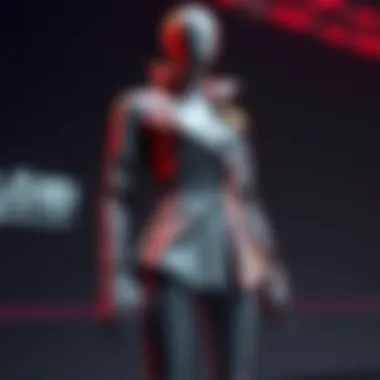Comprehensive Guide to CLO 3D Fashion Design Software


Intro
In the fast-evolving world of fashion, the tools designers use can make or break their creative process. CLO 3D stands as a beacon for those looking to streamline their design workflow and bring ideas to life in a way that paper sketches never could. This software offers a bridge between the imaginations of designers and the functional garments we see in the stores. Its innovative approach does not merely focus on the visual aesthetics but also encompasses the intricacies of textile simulations and pattern design.
The relevance of exploring CLO 3D cannot be understated, especially for small to medium-sized businesses and entrepreneurs who strive to stay competitive. Understanding the nuances of the software can enhance design capabilities, drive efficiency, and foster productivity among teams. With the rise of e-commerce and digital fashion marketing, leveraging such advanced tools becomes imperative for modern designers looking to carve out their niche in a saturated market.
Beyond just a mere description of the user interface or basic functionalities, this detailed article will serve as a guide to navigating the complexities of CLO 3D from download to effective utilization. We will delve into vital software features, offer a comparison of similar tools on the market, and provide tips that will hallmark your journey into the realm of professional fashion design. Let’s get started.
Preamble to CLO 3D Fashion Design Software
In today's fast-paced world of fashion, where trends shift quicker than the blink of an eye, effective design tools are crucial for success. CLO 3D is emerging as a vital software solution for fashion designers, retailers, and entrepreneurs. It allows for a streamlined approach in creating designs, turning creative ideas into tangible products with greater speed and precision.
Overview of CLO 3D
CLO 3D is an advanced fashion design software that enables designers to create virtual garments and visualize them in 3D. Think of it as a digital canvas for fashion, helping designers to sketch, fit, and modify their designs without the need for physical samples. By simulating fabric properties and draping techniques, CLO 3D captures the essence of your design from conception to final presentation. Its user-friendly interface, combined with numerous features, provides opportunities for both seasoned designers and newcomers to express their creativity effectively.
Today, many fashion schools incorporate CLO 3D into their curriculums. This speaks volumes about its effectiveness and relevance in the educational sphere. Students get to learn skills that are directly applicable in the industry, making them more marketable after graduation. For professional designers, CLO 3D becomes an indispensable ally that helps streamline the workflow, enhances collaboration across teams, and reduces costs related to material waste.
Importance in the Fashion Industry
CLO 3D holds significant importance in the fashion industry for several reasons. First and foremost, it enhances efficiency. Designers can iterate on their ideas quickly, saving time and resources. With traditional methods, creating physical prototypes can be a cumbersome process. CLO 3D reduces this burden, allowing for rapid prototyping which is crucial in today’s competitive landscape.
Moreover, the ability to visualize designs in real-time fosters better collaboration among team members. Designers, marketers, and even production teams can come together to review concepts in a virtual space, leading to quicker feedback and adjustments. This level of interaction helps ensure that everyone is on the same page, minimizing costly miscommunications down the line.
Furthermore, the software excels in sustainability. With the fashion industry facing an increasing push toward environmentally-conscious practices, CLO 3D affords designers the ability to experiment without wasting materials. By producing digital samples, brands can reduce their carbon footprint and align themselves with eco-friendly goals.
In summary, CLO 3D Fashion Design Software is more than just a tool. It transforms the entire design process, making it faster, more collaborative, and environmentally responsible. Designers and businesses that harness its features can expect to see a significant impact on their creative and operational processes.
Features of CLO 3D Software
CLO 3D sits at the forefront of fashion design technology, offering a treasury of features that not only elevate creativity but also enhance productivity in a fast-paced industry. Understanding these features is vital, especially for small to medium-sized businesses aiming to carve their niche in the competitive landscape. By grasping the sheer depth of CLO 3D’s capabilities, users can make informed decisions about how best to utilize the software to benefit their unique workflows and objectives.
Advanced Fabric Simulation
The ability to accurately simulate fabric is one of the cornerstones of CLO 3D. The software employs a complex physics engine that considers weight, texture, and drape characteristics of various materials. This means designers can emulate how materials will interact in real life right down to the way a velvet dress sways with movement or how a linen shirt creases. Such realism is crucial for making design choices based on how the finished product will look and behave.
"The most important part of a design isn’t just the style; it’s how it feels in real life. That’s where CLO 3D shines."
Fabrics can be layered, combined, and altered within the software, allowing for a meticulous approach to design. Furthermore, the extensive fabric library—with options ranging from cotton to silk—empowers creators to experiment without needing to source physical swatches. This not only saves time but also streamlines the development process, making it a significant feature of CLO 3D that designers can capitalize on.
Real-time Visualization
When it comes to fashion design, seeing is believing. The real-time visualization feature is a game changer, providing immediate previews of design changes as they're made. This utility allows designers to test various looks without waiting for renderings, making decision-making quicker and more dynamic.
The interactive interface lets users rotate, zoom, and view designs from multiple angles. This is particularly useful for presentations or pitching ideas. The capacity to highlight intricate details in high-definition brings concepts to life as if they were already fully made garments. This feature not only enhances creativity but also improves collaboration among teams, as stakeholders can immediately see and evaluate design progress.


3D Pattern Design
CLO 3D’s capabilities go beyond simple modeling; the software facilitates intricate pattern design, transforming the way patterns are conceived and engineered. Users can create and modify patterns in 3D space, establishing a direct correlation between the digital and physical forms.
By manipulating the pattern shapes in real-time, designers have the freedom to experiment without the constraints of traditional methods. Changes made to a pattern instantly reflect in the 3D view, reducing the risk of errors and the need for tedious revisions later in the production phase. It’s a sophisticated approach that encourages creativity while maintaining practical outcomes.
Avatar Customization
Diversity and personalization are central themes in modern fashion, and CLO 3D meets these demands with its avatar customization feature. Users can create avatars that reflect diverse body types, sizes, and demographic backgrounds. This capability allows designers to visualize how their creations will fit various body shapes, leading to more inclusive designs.
Furthermore, this customization ranges from choosing skin tones to adjusting body measurements, providing a bespoke approach to fashion design. By utilizing tailored avatars, designers can confidently make adjustments, ensuring that their designs resonate with a broader audience. This not only enriches the design process but also enhances the marketing potential of the final products.
Downloading CLO 3D
Downloading CLO 3D is a pivotal step for those itching to enhance their fashion design game. It's not just about getting the software onto your device; it’s about preparing your environment for creativity. Let’s break it down.
System Requirements for Installation
Before diving headfirst into the download, it’s crucial to know if your system can handle CLO 3D. Here’s what you need:
- Operating System: Windows 10 (64-bit) or macOS 10.14 or newer. If you're running older versions, buckle up for an upgrade.
- Processor: Intel i5 or better. Nobody wants a slow computer when inspiration strikes.
- RAM: A minimum of 8 GB RAM is required; however, 16 GB is recommended for seamless multitasking.
- Graphics Card: Compatible with OpenGL 4.1 and up; NVIDIA or AMD graphics cards are favored for better performance.
- Storage: At minimum, 15 GB of free disk space. With all the fabrics and designs you’ll accumulate, you might want to plan for more.
Failing to meet these requirements could result in a frustrating experience, so take a moment to check your specs.
Official Download Sources
When you're ready to download, steer clear of dubious websites. It's best to stick with the official sources to avoid any unnecessary headaches down the road. You can get CLO 3D directly from:
- CLO 3D's Official Website: This is the safest place to find the most recent version. Keep to this site to get all updates without a hitch: clo3d.com.
- Authorized Resellers: If you’re part of an institution or corporation, they might have partnerships that allow for discounted rates. Always worth asking your IT department!
These sources assure you get legitimate software, free from any malicious add-ons which could turn your design dream into a nightmare.
Installation Steps
Now, with your download source settled, it's time for installation. Here’s a simple roadmap to get you going:
- Download the Installer: Click the appropriate link from the official source you chose. If it's a zip file, extract it first.
- Run the Installer: Find the downloaded file and double-click. Follow the prompts that pop up on your screen. This is where a cup of coffee might come in handy while you wait!
- License Agreement: Read through the licensing terms. I know it’s a bore, but it’s better to be informed than surprised.
- Choose Installation Type: Opt for a full installation unless you have specific needs for a custom one.
- Select Installation Location: Here, you can either stick with the default folder or choose a different directory. Just make sure you won’t lose it in the depths of your computer!
- Finalize the Setup: Once everything is set, click install and let it work its magic. Afterward, you may be prompted to restart your computer. Don’t skip this unless you've got a specific reason.
Getting CLO 3D installed correctly is just the beginning. Once it’s all set, you're opening the door to a vast world of fashion design possibilities—so gear up to embark on this creative journey!
Comparing CLO 3D with Other Fashion Design Software
When it comes to fashion design software, the landscape is crowded with options. Each tool comes with its own set of features and advantages. Understanding how CLO 3D stacks up against other solutions can help professionals make informed decisions. In this part of the article, we dissect CLO 3D's capabilities in comparison to its peers—TUKAcad, Optitex, and Gerber Technology. This comparison can highlight strengths, weaknesses, and unique selling points that may influence your choice.
CLO 3D vs. TUKAcad
TUKAcad has carved out a niche focused largely on pattern-making and marking functionalities. While it excels in these areas, CLO 3D shines with its seamless integration of 3D visualization. An important distinction to note is that CLO 3D allows designers to see not only patterns but also how the fabric behaves on avatars in real-time. This feature puts you in the driver's seat for adjustments before any physical production occurs.


Some key differences to consider include:
- User Interface: CLO 3D offers a more visually intuitive interface compared to TUKAcad, which might come across as more technical and less user-friendly for those unfamiliar with pattern design.
- Simulation Capabilities: The fabric simulation in CLO 3D surpasses TUKAcad's offerings, giving users the ability to experiment with various textiles and observe their properties in a lifelike manner.
In summary, if your design process favors comprehensive visualization and realistic simulations, CLO 3D might be more beneficial than TUKAcad.
CLO 3D vs. Optitex
Optitex also competes closely with CLO 3D, particularly in the domain of 3D garment visualization. Nevertheless, CLO 3D takes the advantage with its robust design features and advanced rendering capabilities. For example, the photorealistic outputs provided by CLO 3D make presentations to clients much easier—nothing beats a convincing visual!
When comparing these two, consider:
- Feature Set: CLO 3D boasts a more diversified toolkit that allows for extensive customization options, from avatar customization to detailed fabric settings.
- Rendering Speed: Users often find that CLO 3D’s rendering is faster, providing quick turnarounds during the design workflow, an essential consideration in the fast-paced fashion industry.
Ultimately, for designers who prioritize speed and a rich feature set, CLO 3D stands as a formidable option compared to Optitex.
CLO 3D vs. Gerber Technology
Gerber Technology offers a solid suite of tools aimed primarily at the manufacturing side of fashion. It features strong capabilities in production management and cutting room solutions but lacks the creative flexibility provided by CLO 3D. Designers leveraging CLO 3D’s environments find immediate value in its thoughtful design workflow, while Gerber may cater more to manufacturers looking to fine-tune processes rather than initial designs.
Key points of divergence:
- Creative Features: CLO 3D’s focus is more on design and visualization, making it a go-to for professionals keen on aesthetics and garment drape.
- Integration with Production: While Gerber excels in manufacturing integration, CLO 3D complements this aspect with its ability to produce realistic prototypes first, allowing for easier transition into production phases.
In the end, the choice between CLO 3D and its competitors depends on the specific needs of your fashion design processes, whether they emphasize creative design, production efficiency, or a mix of both. The balance struck will inform how effectively you can innovate in the fast-evolving fashion industry.
"All tools have their unique strengths; knowing which resonates with your workflow is half the battle in effective design."
Relevant Links:
Utilizing CLO 3D for Effective Fashion Design
In today’s fast-paced fashion landscape, designers are constantly on the lookout for tools that streamline their creative process. CLO 3D strides into this arena as a powerful ally, offering a myriad of options that enhance the overall design workflow. Utilizing CLO 3D isn’t merely about replacing traditional processes; it’s about transforming how ideas evolve into reality while also keeping the workflow efficient, organized, and adaptable.
Design Workflow Optimization
Harnessing CLO 3D allows designers to optimize their entire design workflow. Traditional fashion design often involves multiple intricate steps, from sketching to selecting fabrics and creating patterns. Each of these stages can be time-consuming and sometimes fraught with errors. CLO 3D simplifies this process with its integrated functionalities. Designers can sketch, visualize, and tweak their ideas all in one platform. This integration reduces the likelihood of costly mistakes made in the physical prototyping stage.
By modeling designs in a three-dimensional space, one can visualize how elements will interact, be it fabric drapes or layering techniques, in a more realistic manner. The software’s advanced fabric simulation shades light on how materials behave in real-time, enabling designers to make immediate adjustments based on their observations. As a result, this fosters an agile design environment where ideas can be nurtured and refined sooner—before any fabric is cut or sewn.
Moreover, CLO 3D allows for a seamless transition from digital to physical. Since patterns and materials are created within a singular platform, it becomes quicker to export finalized designs for production. This not only speeds up the process but also allows businesses to stay one step ahead of trends, preparing collections that resonate with their target audience.
Collaboration Features
CLO 3D also shines when it comes to collaboration features. In the fashion industry, multiple stakeholders—from designers to manufacturers to marketers—are often involved in a project. CLO 3D enhances this collaborative spirit by providing tools that facilitate communication and sharing. The platform supports multiple users, making it possible for teams to work concurrently on the same design.


A unique aspect of CLO 3D’s collaboration is its ability to enable feedback directly within the design environment. For instance, team members can leave comments or annotations on specific parts of the garment, allowing for quick iterations based on collective inputs. This results in a cohesive workflow as everyone stays in the loop, ensuring that all voices are heard.
Furthermore, the cloud-connectivity ensures that all teams have access to the latest designs, streamlining discussions and decisions, which inherently enhances project efficiency. Teams are no longer relying on cumbersome email threads or physical meetings to discuss designs; everything happens in real-time, reducing delays and miscommunication.
"In the ever-evolving world of fashion, staying connected and aligned is key to success. CLO 3D makes this easier than ever."
In summary, utilizing CLO 3D for effective fashion design translates into smarter workflows and enhanced collaboration. For small to medium-sized businesses and entrepreneurs looking to make their mark, embracing this technology can elevate their design process, making it both efficient and more responsive to the ever-changing demands of the market.
User Experiences and Case Studies
Understanding real-world applications of CLO 3D is vital for those considering this software for their fashion design needs. When small to medium-sized businesses, entrepreneurs, or IT professionals step into the intricate world of fashion design, user experiences and case studies offer a lens through which they can gauge the software's capabilities. These narratives provide insights not just into the software’s usability but highlight its impact on productivity, creativity, and collaboration.
Gathering feedback from users can arm potential adopters with knowledge that transcends basic software features. Information stemming from actual designers and companies can reveal nuanced advantages and hurdles encountered during implementation. This kind of insight is invaluable for making educated decisions when choosing the right design software for unique business needs.
Success Stories from Designers
The fashion industry is rich with stories of creativity spanning cultures and ideologies. Take for instance the journey of Emily Choi, a designer based in New York. Emily crafts high-end ready-to-wear clothing, focusing on sustainable fabrics and ethical practices. After adopting CLO 3D, she reported a drastic reduction in prototyping time, which led to faster turnaround rates for her collections.
"Before CLO 3D, creating a sample would take weeks. Now, I can visualize my ideas immediately and tweak them as I go. It allows me to play with colors and textures without wasting material," she shared.
Through her experience, it's clear that CLO 3D did not merely speed up the design process; it redefined how Emily approached fashion. This flexibility encourages designers like her to experiment — a significant factor in fostering innovation.
Another compelling success story is that of a small business in Paris specializing in custom wedding attire. The designers reported that they could present virtual samples to clients, effectively reducing the back-and-forth traditionally associated with bespoke fashion. One designer noted, "We now have a visual catalog that clients can see before making a decision, which is a game changer in our field."
These narratives underscore the transformative potential of utilizing CLO 3D, where users transformed not just their design workflows but also enriched their customer relationships.
Industry Adoption Case Studies
The wave of CLO 3D adoption extends beyond individual designers; it has seized the attention of established fashion houses and educational institutions. Industry leaders like Nike have implemented CLO 3D into their design processes to innovate and fine-tune their collections with rapid prototyping technologies. By shifting gears from traditional methods, Nike reported a drop in operational inefficiencies.
Similarly, fashion colleges around the world, such as the Fashion Institute of Technology in New York, are integrating CLO 3D into their curriculum. This approach equips students with hands-on experience, merging theoretical knowledge with practical skills. A teacher at the institute stated, "Students are left amazed at how their digital designs can become 3D realities so swiftly. It prepares them for a competitive job market that demands technical proficiency alongside creativity."
Moreover, as the fashion industry grapples with sustainability challenges, CASE Corp, a textile manufacturer, adopted CLO 3D to minimize fabric waste. By generating virtual prototypes, they reduced the number of physical samples created, leading to a more eco-friendly approach in their design and production processes. The company's CEO explained, "CLO 3D has radically changed our perspective on sustainable fashion practices. Less waste means better environmental stewardship and efficiency."
These cases provide compelling evidence that CLO 3D is not just reshaping individual design practices but is also influencing broader industry dynamics. The software stands as a beacon for those aiming to navigate the evolving landscape of fashion, reinforcing it as an essential tool in modern garment design.
Closure and Future Prospects
As we circle back to our exploration of CLO 3D fashion design software, it’s essential to reflect on the countless possibilities that this tool presents to fashion designers and businesses alike. The fashion industry is in a constant state of flux, evolving with technological advancements and shifting consumer demands. In this context, CLO 3D emerges not merely as a software but as a pivotal player that shapes the trajectory of modern fashion design.
Summary of Key Points
To boil it all down, here are the key takeaways from this article:
- Innovative Features: CLO 3D offers advanced fabric simulations, real-time visualizations, custom avatar design, and a seamless pattern design interface. These elements enhance creativity and precision, essential for modern designers.
- User Experiences: The software has gained traction among numerous designers, with real-life success stories highlighting its transformative impact on design workflows and collaborative projects.
- Comparative Analysis: When put alongside competitors such as TUKAcad and Optitex, CLO 3D showcases unique features that set it apart, making it a favorable choice for fashion professionals seeking efficiency and innovation.
- Download and Utilization Guidance: Steps to download and install the software were laid out, catering especially to those in small to medium-sized businesses looking to optimize their design processes.
Future Developments in CLO 3D
Looking ahead, CLO 3D is on a promising path filled with potential advancements. As technology develops, we can expect several key trends:
- AI Integration: The incorporation of artificial intelligence could enhance design capabilities, allowing for predictive modeling that anticipates trends and consumer preferences based on historical data.
- Enhanced Virtual Reality Experience: Future iterations may offer more immersive experiences in virtual reality, allowing designers to visualize their work in an interactive environment, something that could revolutionize the design pitch phase.
- Sustainability Features: With increasing awareness of the fashion industry's environmental impact, future updates might focus on tools that help designers create sustainable fashion solutions more efficiently.
- Collaboration Tools: As remote work continues to be a necessity for many businesses, enhancing features for collaborative design may further facilitate teamwork among designers, manufacturers, and clients, bridging gaps that geographical distance may impose.
In summation, CLO 3D stands as a cornerstone in the future of fashion design. By adopting it and keeping an eye on forthcoming enhancements, businesses can position themselves to remain ahead of the curve, adapt swiftly, and thrive in a rapidly changing industry. With each update and new feature, CLO 3D not only aids in the creative process but also serves as a strategic ally in cultivating sustainable fashion practices.



